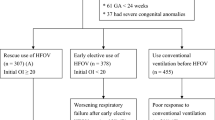Abstract
OBJECTIVE:
To determine the efficacy and safety of high-frequency oscillatory ventilation (HFOV) compared to conventional ventilation (CV) for the treatment of respiratory failure in term and near-term infants in Colombia.
STUDY DESIGN:
Eligible infants with moderate to severe respiratory failure were randomized to early treatment with CV or HFOV. Ventilator management and general patient care were standardized. The main outcome was neonatal death or pulmonary air leak.
RESULTS:
A total of 119 infants were enrolled (55 in the HFOV group; 64 in the CV group) during the study period. Six infants in the HFOV group (11%) and two infants in the CV group (3%) developed the primary outcome (RR: 3.6, 95% CI: 0.8–16.9). Five infants in the HFOV group (9%) and one infant in the CV (2%) died before 28 days of life (RR: 5.9 CI: 0.7–48.2). Secondary outcomes were similar between groups.
CONCLUSION:
HFOV may not be superior to CV as an early treatment for respiratory failure in this age group. Standardization of ventilator management and general patient care may have a greater impact on the outcome in Colombia than mode of ventilation.
This is a preview of subscription content, access via your institution
Access options
Subscribe to this journal
Receive 12 print issues and online access
$259.00 per year
only $21.58 per issue
Buy this article
- Purchase on Springer Link
- Instant access to full article PDF
Prices may be subject to local taxes which are calculated during checkout
Similar content being viewed by others
References
Parker JC, Hernandez LA, Peevy KJ . Mechanisms of ventilator-induced lung injury. Crit Care Med 1993;21:131–143.
Dreyfuss D, Saumon G . Role of tidal volume, FRC, and end-inspiratory volume in the development of pulmonary edema following mechanical ventilation. Am Rev Respir Dis 1993;148:1194–1203.
Yoder BA, Siler-Khodr T, Winter VT, et al. High frequency oscillatory ventilation. Effects on lung function, mechanics, and airway cytokines in the immature baboon model for neonatal chronic lung disease. Am J Respir Crit Care Med 2000;162:1867–1876.
McCulloch PR, Forkert PG, Froese AB . Lung volume maintenance prevents lung injury during high frequency oscillatory ventilation in surfactant deficient rabbits. Am Rev Respir Dis 1988;137:1185–1192.
deLemos RA, Coalson JJ, Gertsmann DR, et al. Ventilatory management of infant baboons with hyaline membrane disease; the use of high frequency ventilation. Pediatr Res 1987;21:594–602.
Carter JM, Gerstmann DR, Clark RH, et al. High-frequency oscillatory ventilation and extracorporeal membrane oxygenation for the treatment of acute neonatal respiratory failure. Pediatrics 1990;85:159–164.
Clark RH, Yoder BA, Sell MS . Prospective, randomized comparison of high-frequency oscillation and conventional ventilation in candidates for extra-corporeal membrane oxygenation. J Pediatr 1994;124:447–454.
Bhuta T, Clark RH, Henderson-Smart DJ . Rescue high frequency oscillatory ventilation vs conventional ventilation for infants with severe pulmonary dysfunction born at or near term. Cochrane Database Syst Rev 2001; (1):CD002974 (online reference).
Kinsella JP, Truog WE, Walsh WF, et al. Randomized, multicenter trial of inhaled nitric oxide and high-frequency oscillatory ventilation in severe, persistent pulmonary hypertension of the newborn. J Pediatr 1997;131:55–62.
American Academy of Pediatrics. Policy Statement: organizational principals to guide and define the child health care system and/or improve the health of children. Committee on the Fetus and Newborn. Levels of neonatal care. Pediatrics 2004;114:1341–1347.
Papile LA, Burnstein J, Burnstein R, et al. Incidence and evolution of subependymal and intraventricular hemorrhage: study of infants with birth weight less than 1,500 gm. J Pediatr 1978;92:529–534.
Leung WC, Lam HS, Lam KW, et al. Unexpected reduction in the incidence of birth trauma and birth asphyxia related to instrumental deliveries during the study period: was this the Hawthorne effect? BJOG 2003;110:319–322.
Braunholtz DA, Edwards SJ, Lilford RJ . Are randomized trials good for us (in the short term)? Evidence for a “trial effect”. J Clin Epidemiol 2001;54:217–224.
Clark RH, Gerstmann DR, Jobe AH, et al. Lung injury in neonates: causes, strategies for prevention, and long-term consequences. J Pediatr 2001;139:478–486.
van Kaam AH, Haitsma JJ, De Jaegere A, et al. Open lung ventilation improves gas exchange and attenuates secondary lung injury in a piglet model of meconium aspiration. Crit Care Med 2004;32:443–449.
Rais-Bahrami K, Rivera O, Winslow R, et al. Effect of nitric oxide and high-frequency oscillatory ventilation in meconium aspiration syndrome. Pediatr Crit Care Med 2000;1:1666–1669.
Acknowledgements
We gratefully acknowledge the contribution of the research assistants from each participating center for data collection as well as the respiratory therapists and nursing staff for making this study possible. We thank Gennie Bose for supporting nurse staff training in Colombia and Dr. Juan Gabriel Ruiz for his involvement in the SRC and the interim analysis, and Esperanza Peña for helping us coordinate this study. We also thank Dr. Diane Marshall for proof reading this manuscript and Dr. Reese Clark for his contribution during the initial design of this study and review of the manuscript.
Author information
Authors and Affiliations
Consortia
Additional information
Research supported in part by SensorMedics Corporation and the American Lung Association of North Carolina.
Supplementary Information accompanies the paper on the Journal of Perinatology website (http://www.nature.com/jp)
Supplementary information
Rights and permissions
About this article
Cite this article
Rojas, M., Lozano, J., Rojas, M. et al. Randomized, Multicenter Trial of Conventional Ventilation Versus High-Frequency Oscillatory Ventilation for the Early Management of Respiratory Failure in Term or Near-Term Infants in Colombia. J Perinatol 25, 720–724 (2005). https://doi.org/10.1038/sj.jp.7211386
Published:
Issue Date:
DOI: https://doi.org/10.1038/sj.jp.7211386
This article is cited by
-
International collaborative research: a Colombian model that promotes infant health and research capacity
Journal of Perinatology (2007)



